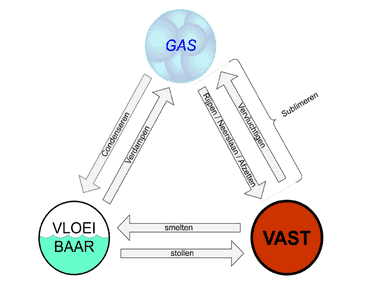Subjects:
- Aggregate states
Aggregate states:
States of matter, such as solid, liquid, and gaseous, are ways in which substances behave under different conditions. This is not only true in science, but also has an important role in everyday applications, such as car air conditioning. In this story we take a closer look at what these states mean, especially in relation to car air conditioning. We take the refrigerant R134a as an example to make it clearer.
Substances can exist in different states: solid, liquid and gaseous. This depends on how hot or cold it is and how much pressure there is. When the temperature is low, the substance is usually solid, like ice. At higher temperatures it becomes liquid, such as water, and at even higher temperatures it turns into a gas, such as water vapour. We call this change of state phase transitions.
Understanding phase transitions is very important in automotive air conditioning. The refrigerant, such as R134a, is crucial here. The refrigerant is constantly changing from liquid to gas and back again. During evaporation, the refrigerant absorbs heat and turns into gas. Then it is compressed, turning it back to liquid and giving off heat. This repeated cycle ensures that the temperature inside the car is properly regulated.

condensation: Condensation is the process by which a gas changes to the liquid phase when it is cooled. In a car air conditioning system, this is a critical step to remove heat from the car's interior and create a cooling effect. When the refrigerant, usually R134a or R1234YF refrigerant, passes through the evaporator, it absorbs heat from the ambient air inside the car. This heat absorption process cools the air in the interior. Because the refrigerant is exposed to relatively warm air at this point, it vaporizes and passes into the gaseous phase. This gas is then sucked in by the compressor. In the compressor, the gaseous refrigerant is compressed, putting it under high pressure and significantly increasing in temperature. This hot, compressed gaseous phase of the refrigerant leaves the compressor and flows through the condenser.
Overheating: Overheating occurs when there is too little liquid refrigerant in the system and the gas being compressed by the compressor becomes warmer than normal. This can have several negative effects on the operation of the air conditioning system and passenger comfort. If there is not enough liquid to dissipate the heat generated by the compressor, the gas pressed by the compressor can reach an undesirably high temperature. This can lead to reduced cooling capacity and even damage to the compressor and other components in the system. In addition, overheating can affect the efficiency of the entire air conditioning system. The system will have to use more energy to reach the desired interior temperature, resulting in higher fuel consumption and potentially reduced system life.
Cooking temperature: This is equal to the condensing temperature and depends on the pressure. The boiling temperature is the temperature at which a vaporous substance begins to condense and changes back to liquid form. In the case of an air conditioning system, the refrigerant, now in vapor form, is passed through the condenser section of the system. Here, heat is dissipated to the environment, causing the refrigerant to cool and condense into a liquid. This process of condensation ensures that the heat absorbed in the evaporator is now released to the environment outside the air conditioning system.
Saturated Vapor: In an air conditioning system, saturated vapor is when both the vapor and liquid of the same refrigerant are present. In other words, the saturated vapor is the vapor that is just beginning to condense at a certain temperature and pressure.
Hypothermia: Hypothermia occurs when the liquid in the refrigerant is colder than its boiling (condensation) temperature. This can cause various problems and adversely affect the performance of the air conditioning system. If the liquid is too cold, it may freeze as it passes through the evaporator. This can lead to icing on the evaporator and restricted airflow, resulting in a loss of cooling capacity and even possible damage to the evaporator. Bin addition, subcooling can reduce the overall efficiency of the system. It can cause the system to take longer to reach the desired temperature, making passengers less comfortable in the vehicle.
